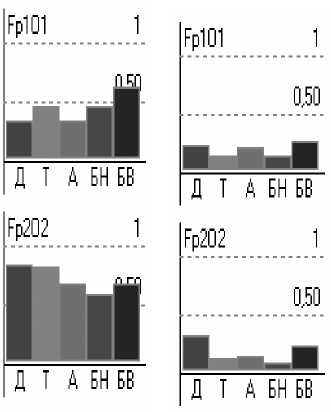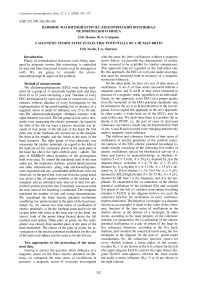A magnetic storm affects electric potentials of a human brain
Автор: Novik O.B., Smirnov F.A.
Журнал: Солнечно-земная физика @solnechno-zemnaya-fizika
Статья в выпуске: 12 т.2, 2008 года.
Бесплатный доступ
Короткий адрес: https://sciup.org/142103288
IDR: 142103288 | УДК: 551.509.336,550.385
Текст статьи A magnetic storm affects electric potentials of a human brain
Plenty of technological processes were being damaged by magnetic storms. But technology is controlled by men and their functional systems may be damaged as well. We are going to consider the electo-neurophysiological aspect of the problem.
Method of measurements
The electroencephalograms (EEG) were being registered for a group of 13 practically healthy girls and boys from 18 to 23 years old during a year. Duration of every EEG investigation by open eyes and by closed ones was 2 minutes, whereas duration of every investigation by the implementation of the proof-reading test in absence of a magnetic storm or under its influence was 15 to 30 min-utes.The electroencephalograph « Нейрон спектр » with eight channels was used. The left group of four active electrodes were measuring the electric potentials (in regard to the lobe of the left ear were a passive electrode was located) of four points of the left part of the head: the first point was at the forehead, the second one at the sinciput, the third at the temple, and the fourth at the back of the head (occiput). The right group of four electrodes was measuring the electric potentials (in regard to the lobe of the right ear) of the symmetric points at the same parts of the head but above the right cerebral semi - sphere. The data of IZMIRAN about dynamics of the geomagnetic field were used. To control the functional state of the men under test, the respiratory rhythms, arterial blood pressure and other characteristics, along with electrocardiograms, were registered and any considerable deflections were not observed. As the proof-test, everyone from the group tested was given a line of random symbols at the monitor of a computer and an unlimited time interval to find two prescribed symbols from this line. Everybody was known that the time interval for searching is unlimited. The computer registered the number of true and wrong determinations. We considered the brain electric potential oscillations combining two points located in the parts of the head mentioned. So, we choose two time series of oscillations of electric potentials: a) for the forehead point and b) for the occiput point (the point at the back part of the head, see above), both of the points being located above the left cerebral semi-sphere. Other pairs of points for this semisphere was chosen from another pairs of the parts of the head mentioned. The choice of the pairs of points for investigation of the electric potential oscillations for the case of the right semi-sphere was the same as for the left one.
Two approaches to the processing of the measured data
Aiming to answer the question about influence of a magnetic storm on the brain electric potential oscillations, we compared the time series of oscillations in presence a magnetic storm of everyone investigated with the same his (her) oscillations without a magnetic storm (below, we describe the characteristic of oscillations occurred to be available for similar comparison). This approach may be regarded as the individual one. By this approach, the EEG of everyone under investigation must be measured both in presence of a magnetic storm and without it.
On the other hand, we have two sets of time series of oscillations: 1) set A of time series measured without a magnetic storm and 2) set B of time series measured in presence of a magnetic storm, regardless to an individual. Surely, by this approach, every EEG (of a proper quality from the viewpoint of the EEG practical standards) may be included in the set A or B and therefore in the investigation. Let us regard this approach as the set’s approach. In other words, a wider total set of the EEG’s may be used in this case. We shall show there is a number (let us denote it by PCDC, i.e. the part of cases of decreased coherence, see below), which may be determined for both of sets A and B and occurred to be changing distinctively under a magnetic storm influence.
The rhythms and coherence function of time series of oscillations of electric potentials of the cerebral cortex. An analysis of the EEG electric potential recordings includes usually extracting of the following five modes of electric oscillations, typical for bioelectrical activity of a brain and known in neuro-physiology as rhythms: δ -rhythm (f = 0.5–3.9 Hz, A = 20 µ V), denoted by Д at the diagram below; ө -rhythm (f = 4–7.9 Hz, A = 20 µ V), denoted by Т ; α -rhythm (f = 8–13 Hz, A = 15 µ V), denoted by А ; β -low-rhythm f = 14–19.9 Hz, A = 5 µ V), denoted by БН ; β -high-rhythm (f = 20–35 Hz, A = 5 µ V), denoted by БВ ; here f is the frequency and A is the amplitude. To characterize the co-ordination of the electric potential oscillations of the forehead (Fp) and occipital (O) points of the left (1) cerebral semi-sphere (resulting notation is Fp1O1 at the diagram below), we used the coherence function for oscillations in every oscillatory rhythm mentioned. The height of a rectangle at a diagram (shown as an example) is equal to the value of the coherence function of the time series of oscillations in the rhythm shown at the bottom of a rectangle. In other words, according to the main property of the coherence function we characterize the co-ordination of the electric potential oscillations of a pair of points of the head by five coherence functions, according to the five basic rhythms, and visualize the numerical result using the five rectangles at the diagram for the pair of points under consideration. So, the coherence function values for every rhythm without a storm (index of the cosmic weather K p < 3) are shown in the left column for the left (the upper diagram Fp1O1) and for the right (lower diagram Fp2O2) semi-spheres, whereas the same results but under a storm influence (K p = 5 or 6) are shown in the right column.
Влияние магнитной бури на электрический потенциал человеческого мозга

Fig. 1.
The main result in terms of the individual approach
At ten diagrams similar to one shown here and measured during the proof-reading test implementation, the coherent function value (CFV) for the low-frequency rhythm T is decreased considerably (rather approximately, half as many, in most of the computed cases) during or after (up to 24 hours) magnetic storms, both for the left and right forehead-occipital pairs. Typically, a distinctive decrease or increase of the forehead-occipital coherence function for all of the higher frequency rhythms А , Б H, БВ is absent though this decrease is seen at this separate diagram (variations of measured data for different men).
The main result in terms of the set’s approach.
We considered 26 coherence function values (CFV) corresponding to 13 Fp1O1 and 13 Fp2O2 ө -rhythm channels measured by a magnetic storm ( K p > 5) during the proof-reading test implementation and determined the part of cases of the decreased coherence (PCDC), i.e. the part of cases when the CFV ≤ 0.2, where 0.2 was chosen as a threshold (i.e. maximal) value of coherence function regarded as a decreased value. We obtained 22 cases of decreases of the CFV’s, see the left (first) column of the table. Then we used 0.3 as the threshold value of the coherence function and the CFV ≤ 0.3 were regarded as decreased ones. We obtained 24 cases (from the total 26) of the decreased CFV’s by this higher threshold (2-nd column). The mean CFV = 0.2 by a magnetic storm.(3-d column).
|
PCDC, K p >5 Thresh. 0.2 |
PCDC, K p >5 Thresh. 0.3 |
Mean CFV K p > 5 |
PCDC, K p <5 Thresh. 0.2 |
PCDC, K p <5 Thresh. 0.3 |
Mean CFV K p < 5 |
|
22/26 |
24/26 |
0.2 |
5/24 |
10/24 |
0.4 |
During the same test but without a magnetic storm (Kp < 5) the PCDC = 5/24 by the threshold of 0.2 (4-th column) and 10/24 by the threshold of 0.3 (5-th column), whereas the mean CFV = 0.4. So, the decreases of the CFV’s occur more often by magnetic storms then without them.
Conclusion. In terms of both the individual and set’s approaches, a magnetic storm decreases the coherence of the brain electric potential ө -rhythm oscillations for the forehead-occipital pair of the points of the head during the proof-reading test implementation, the effect disappears after 2 days. The distinctive effect was not observed without any of the conditions mentioned.
Ase of the open or closed eyes, i.e. without the proof-test implementations, in the case of considered pair of points Fp1O1 and Fp2O2 are omitted here as well as computed diagrams for pairs of points from all other parts of the head included in the EEG measurements (see above) because we did not observe a distinctive coherence function decrease or increase for any rhythm in these cases. Moreover, analysis of a wider sample of the EEGs then we were able to demonstrate here shows that the decrease of the forehead-occipital coherence function for the δ -rhythm ( Д ) is not so typical as for the ө -rhythm ( Т ). Besides, we omit the diagrams showing that the changes of the coherent function disappear 48 hours after the magnetic storm.
We noticed the decrease of the forehead-occipital ө -rhythm coherence function as a general response to a magnetic storm but, surely, there are particularities of the separate tested ones, e.g.: in the case of Гр this decrease is observed for the right semi-sphere only (may be, because of 24 hours passed after the storm); in the case of Мат , the decrease is up to the zero. Besides, particularities of a separate (personal) response to the magnetic storm may be caused by particularities of the magnetic storm (storms) developed during or before the EGG measurement of the person concerned. Possibly, some of the magnetic storm particularities, which are of importance for the brain bio-electric processes, are not reflected by the ionosphere k index dynamics. We considered here the simplest approach from the geophysical, neuro-physiological and mathematical viewpoints.


